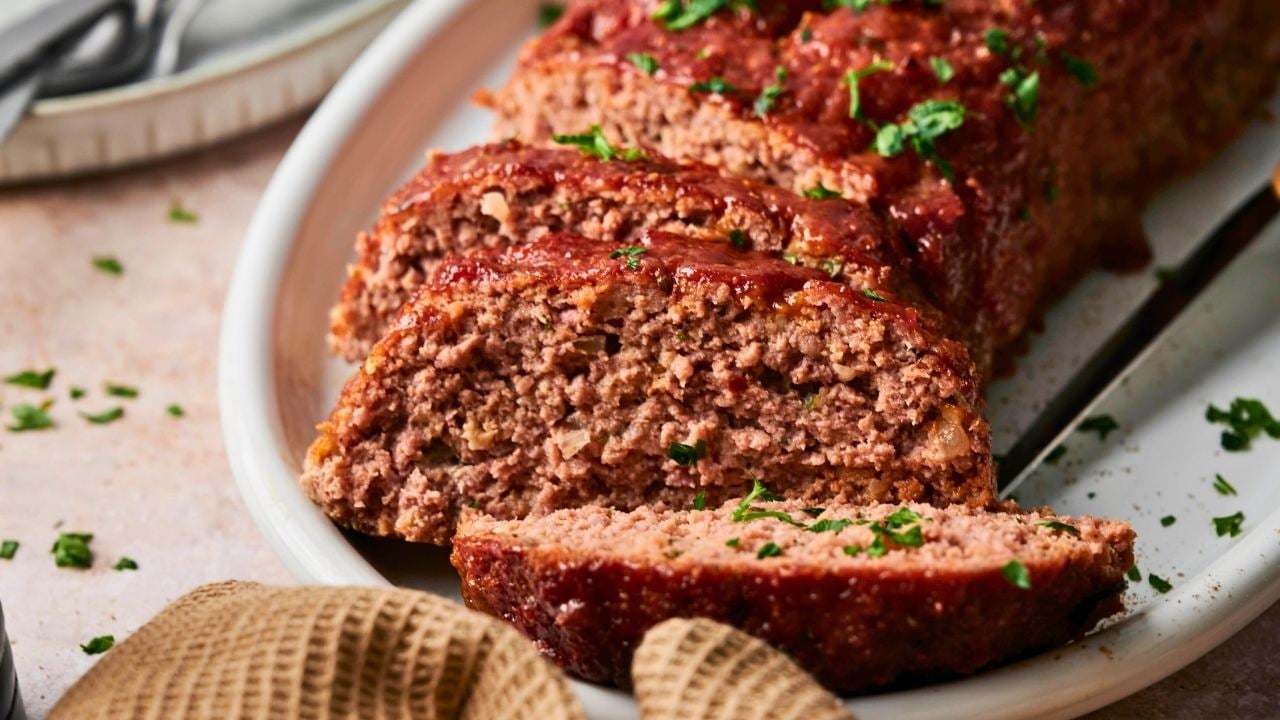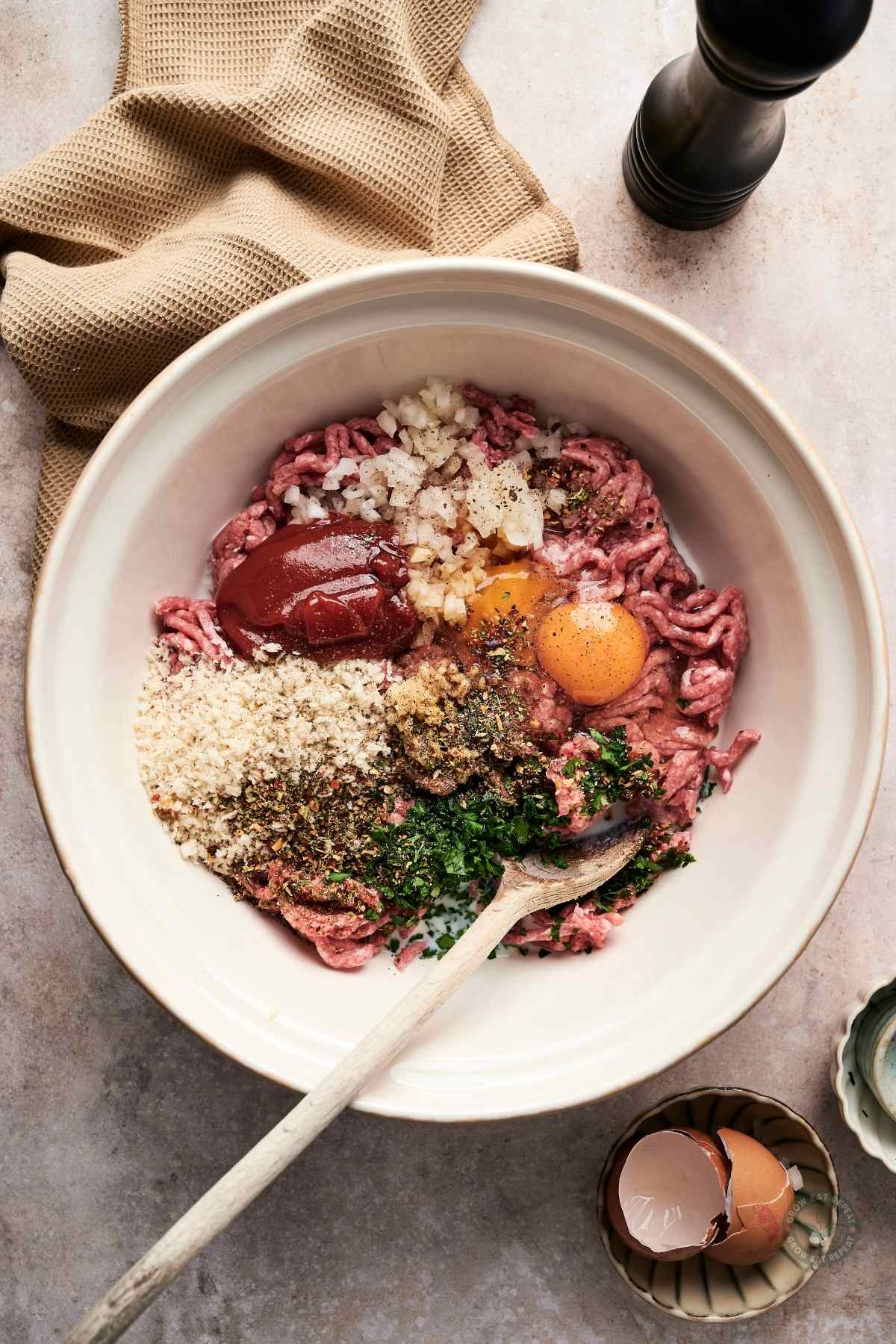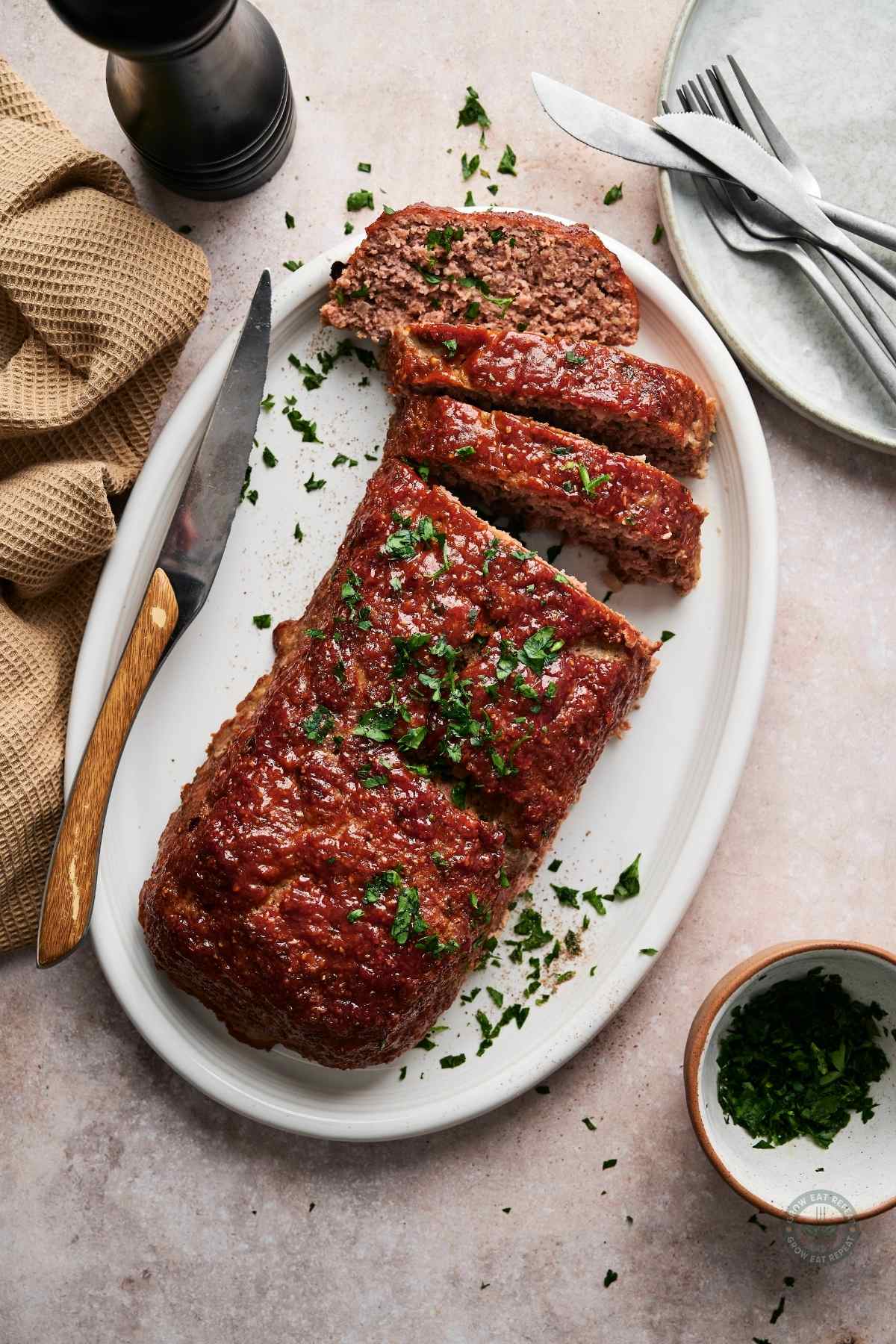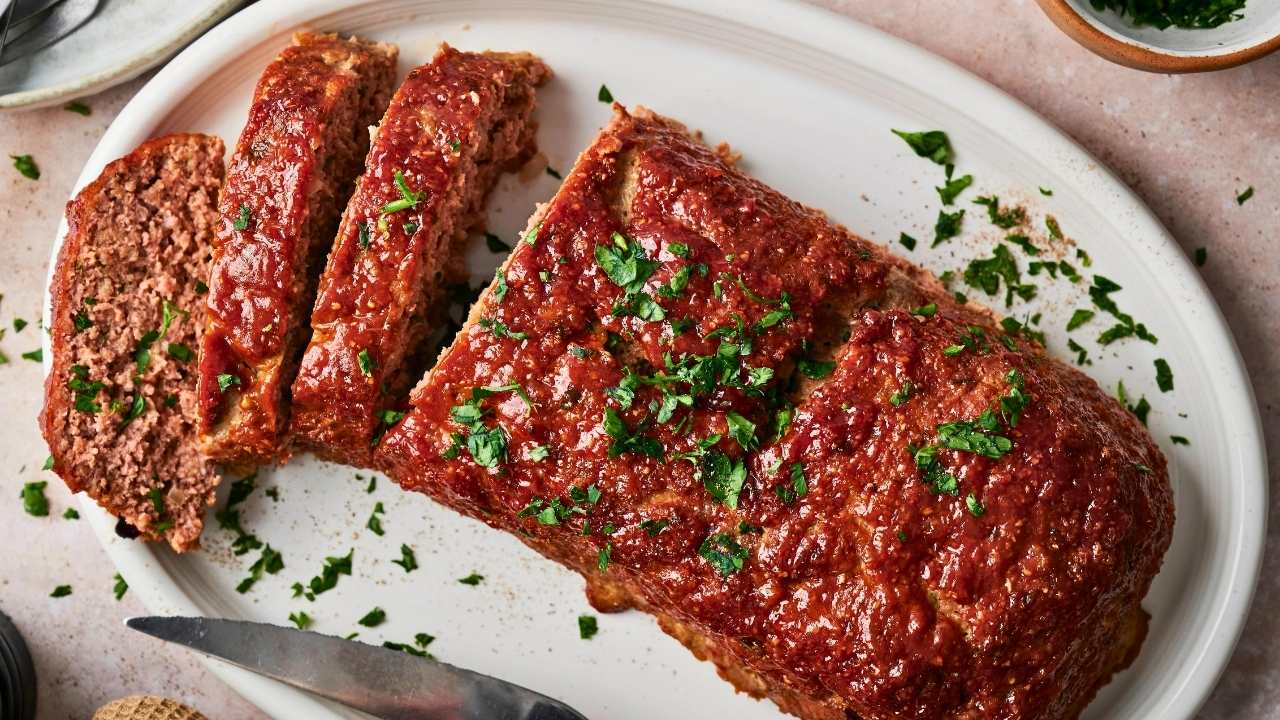America’s Most Craved: The Best Meatloaf Recipe Taking Over Kitchens
The secret to turning ordinary ground beef into the most incredible, juicy meatloaf you’ve ever tasted—no more dry, cardboard disasters.

Let’s be honest here. You’ve probably eaten some terrible meatloaf in your life. Maybe your mom made it dry as cardboard, or that restaurant served you something that looked like a brick and tasted even worse.
Those days are over.
This isn’t just another meatloaf recipe thrown together by someone who thinks cooking means opening a can. This is the result of understanding exactly why meatloaf works, and more importantly why it fails so spectacularly sometimes.
You’re about to discover the secrets that turn ordinary ground beef into the most incredible, juicy, flavorful meatloaf you’ve ever tasted. Whether you’re gluten-free, dairy-free, trying to eat healthier, or just want to blow everyone’s mind at Sunday dinner, we have you covered.
Creating the Best Recipe for Meatloaf

This is it. The recipe that ends your search for meatloaf perfection. But here’s the thing, it’s not just about following directions like a robot. It’s about understanding what makes each ingredient essential and why some ingredients can completely ruin everything.
Base Recipe – Serves 6-8
Prep Time: 15 minutes
Cook Time: 60 minutes
Total Time: 1 hour 15 minutes
Internal Temperature: 160°F (71°C)
Ingredients:
For the Meatloaf:
- 2 lbs ground beef (80-85% lean) – this ratio is crucial, trust me on this
- 2 large eggs
- 3/4 cup whole milk
- 3/4 cup Panko breadcrumbs
- 1 medium onion, finely chopped
- 3 cloves garlic, minced
- 1/4 cup fresh parsley, chopped
- 1/4 cup ketchup
- 2 tbsp Worcestershire sauce
- 1 tsp salt
- 1/2 tsp black pepper
- 1 tsp Italian seasoning
For the Glaze:
- 1/2 cup ketchup
- 2 tbsp brown sugar
- 1 tsp white vinegar
- 1/2 tsp garlic powder
- 1/4 tsp onion powder
Instructions:
- Preheat oven to 350°F (175°C). Don’t skip preheating, it matters more than you think it does.
- Prepare the panade: In a large bowl, whisk together eggs, milk, and ketchup. Add Panko breadcrumbs and let soak for 5 minutes. This step is magic. Seriously, don’t rush it.
- Add aromatics: Stir in chopped onion, garlic, parsley, Worcestershire sauce, salt, pepper, and Italian seasoning. Your kitchen should smell amazing right about now.
- Incorporate meat: Add ground beef to the mixture. Using your hands or a fork, gently combine until just mixed. Do not overmix. This is where most people mess everything up.
- Shape: Form mixture into a loaf shape on a parchment-lined baking sheet or place in a greased 9×5-inch loaf pan. Both work great but there’s differences we’ll talk about later.
- Make glaze: Whisk together all glaze ingredients. Brush half over the meatloaf. Save the rest, you’ll need it.
- Bake: Cook for 45-60 minutes, applying remaining glaze every 15 minutes, until internal temperature reaches 160°F. Use a thermometer here. Guessing is for amateurs.
- Rest: Let stand 10-15 minutes before slicing. I know it’s hard to wait but this step separates good meatloaf from great meatloaf.
The Science Behind Perfect Meatloaf

Here’s where we separate the cookbook followers from the meatloaf masters. Understanding why things work means you can adapt, improvise, and never make a bad meatloaf again. Plus you’ll sound really smart at dinner parties.
Why This Easy Recipe Actually Works
The 80-85% Lean Ground Beef Choice
Fat isn’t the enemy here, it’s your best friend. As your meatloaf bakes, that intramuscular fat renders and basically bastes the meat from the inside. It’s like having tiny little butter packets throughout your loaf melting at just the right time.
Using 90% lean beef? You might as well make a hockey puck. Without enough fat you get dry, crumbly sadness on a plate. Been there, done that, never again.
The Magic of Panade (Breadcrumbs + Milk)
This isn’t just some French cooking term to sound fancy. It’s the secret weapon that separates amazing meatloaf from the cardboard stuff your aunt used to make back in the 80s.
Here’s what happens. The breadcrumbs soak up that milk and create little moisture pockets throughout your meatloaf. When everything bakes, these pockets swell up and interrupt the meat proteins from linking together too tightly. Less protein linking equals more tender meatloaf.
Panko breadcrumbs work better than regular ones because they’re lighter and fluffier. They create more space, more tenderness. It’s not rocket science but it works like magic every single time.
The Binding System That Actually Binds
Eggs do the heavy lifting here. They coagulate during cooking and literally hold everything together while those hydrated breadcrumbs are doing their moisture thing. It’s teamwork at its finest.
Most recipes just tell you to throw everything together and hope for the best. But when you understand how these ingredients work together, you can troubleshoot problems before they even happen.
Pro Techniques That Make The Difference

This is where good cooks become great cooks. These aren’t just tips, they’re the difference between meatloaf that impresses and meatloaf that gets forgotten about or worse, avoided entirely.
Mixing Method (This is Critical, Don’t Mess This Up)
The Right Order Matters:
- Mix all wet ingredients first (eggs, milk, ketchup, Worcestershire)
- Add breadcrumbs and let soak 5 minutes – seriously, set a timer
- Add seasonings to the wet mixture
- Gently fold in meat last – use hands or fork, never a mixer
- Stop the moment everything looks combined
Why This Works: Overmixing is the #1 reason people make terrible meatloaf. When you overwork ground meat you develop those myosin proteins too much. The result? Dense, rubbery texture that nobody wants to eat twice.
Mix just until combined. Then stop. Your restraint here pays off big time.
Shaping Options (Each Has Its Purpose)
Free-Form on Baking Sheet:
This is my personal favorite honestly. You get more caramelized crust because air circulates better around the whole thing. The fat drains away instead of pooling at the bottom making everything greasy. Your meatloaf actually looks more rustic and appealing too.
The downside? If your mixture is too wet it might spread out like a pancake. Not a good look.
Traditional Loaf Pan:
Classic shape that everybody recognizes. Retains moisture because the meatloaf cooks in its own juices. Better for beginners since it’s basically foolproof for shape.
But you get less crust development and sometimes the bottom can get a bit soggy if there’s too much fat.
Mini Meatloaves (Muffin Tins):
These are genius for meal prep. Cook way faster, about 25-30 minutes. More glaze per portion which is always good. Perfect individual sizes.
Temperature Control
Use an instant-read thermometer in the center of your meatloaf. Pull it at 155°F and let rest, it’ll reach 160°F during resting. If the top browns too quickly, tent with foil.
Don’t rely on time alone, ovens vary way too much for that.
Meat Variations for Every Preference

Not everyone wants the same meatloaf and that’s totally fine. Here’s how to customize your protein base without ruining everything you’ve learned so far.
Classic Upgrades
The Rich Blend (Beef + Pork):
Try 1.5 lbs ground beef plus 0.5 lb ground pork. The result is significantly juicier with richer flavor. Pork has more fat content naturally which helps with moisture big time.
Traditional “Meatloaf Mix”:
Equal parts ground beef, pork, and veal (or turkey if veal’s too expensive). This gives you enhanced moisture and tenderness that’s hard to beat.
Italian-Style:
Use 1.5 lbs ground beef plus 0.5 lb Italian sausage with casings removed. The sausage brings built-in seasoning from all those spices. Less work for you, more flavor for everyone.
Leaner Options (With Safeguards)
For 90% Lean Beef or Turkey:
You need to compensate for the missing fat somehow. Add 2 tbsp olive oil to the mixture. Increase vegetables by 1/2 cup. Consider adding 30% ground pork for fat content. Use egg whites plus 1 whole egg instead of 2 whole eggs.
Without these adjustments you’re asking for trouble.
Dietary Adaptations

Life happens and sometimes you need to work around dietary restrictions. The good news is meatloaf is pretty adaptable if you know what you’re doing.
Gluten-Free Options
Breadcrumb Replacements:
Best option: 3/4 cup gluten-free Panko breadcrumbs
Alternative: 3/4 cup certified gluten-free rolled oats (quick-cooking preferred)
Budget-friendly: Crushed gluten-free crackers
Important: Make sure your Worcestershire sauce is gluten-free too. Lea & Perrins in the US is usually safe but always check labels because formulations change.
Dairy-Free Substitutions
Milk Replacements (3/4 cup):
Unsweetened almond, soy, or oat milk work great. Chicken or beef broth adds savory depth instead of richness. Coconut milk works but use the light version unless you want everything to taste like coconut.
Egg-Free Binding
Per Egg Replacement:
Flax eggs: 1 tbsp ground flaxseed plus 3 tbsp water, let sit 5-10 minutes until gooey
Aquafaba: 3 tbsp chickpea liquid from the can
Commercial egg replacer: Follow package instructions
Flax eggs work really well here, aquafaba is more neutral tasting.
Low-Fat Version
Modifications:
Use 93% lean ground beef or turkey but you’ll need help. Add 1 cup finely chopped, sautéed vegetables like mushrooms, zucchini, carrots. Use 1 whole egg plus 2 egg whites for binding. Bake on a rack to let fat drain away.
Plant-Based (Vegan) Meatloaf
Base (Replaces 2 lbs meat):
2 cups cooked brown lentils, 1 (15-oz) can chickpeas mashed up (save the liquid for binding), 8 oz finely diced sautéed mushrooms, 1 cup sautéed vegetables like onion, carrot, celery.
Binding System:
3/4 cup rolled oats, 2 flax eggs (2 tbsp ground flax plus 6 tbsp water or that aquafaba), 1/4 cup ketchup, 2 tbsp vegan Worcestershire sauce, 1 tbsp soy sauce or tamari.
Baking: 375°F for 45-55 minutes until firm to touch.
Aromatic & Vegetable Enhancements
This is where you can really make your meatloaf special. Most people just throw in raw onions and call it a day but there’s so much more you can do.
Onion Upgrade Techniques
Sautéed Onions:
Cook 1 medium diced onion in oil until soft and translucent, about 5-7 minutes. This eliminates that harsh raw onion bite and adds natural sweetness. Way better than raw.
Grated Onions:
Grate 1 medium onion directly into your mixture. It melts into the meatloaf and creates this velvety texture. Squeeze out excess liquid if it’s really watery though.
Additional Vegetables for Moisture & Flavor
Recommended Additions (1/2 to 1 cup total, sautéed first):
Carrots finely diced, celery finely diced, bell peppers any color, mushrooms (cremini or button), zucchini diced with excess moisture squeezed out.
Why Sauté First: Controls moisture release so your meatloaf doesn’t get soggy. Concentrates flavors. Ensures everything’s tender when the meatloaf is done.
Raw vegetables can release unpredictable amounts of water during cooking which messes with your texture.
Flavor Variations & International Twists
Once you master the basic recipe it’s time to have some fun. These variations will keep your family interested and give you bragging rights.
Spice & Herb Innovations
Smoky & Savory:
Add 1 tsp smoked paprika, 1/2 tsp ground cumin, pinch of cayenne pepper. This gives you that barbecue depth without actually grilling.
Herbaceous Italian:
Increase Italian seasoning to 1 tsp, add 1/2 tsp dried oregano, add 1/4 tsp dried basil. Very aromatic, very satisfying.
Mustard Kick:
Add 1 tsp ground mustard to meat mixture. Gives you subtle tang and complexity that most people can’t quite identify but they know they like it.
International Flavor Profiles
Italian-Style:
Mix in 1/2 cup marinara sauce, add mozzarella cheese center (stuff it in the middle), serve with additional marinara on the side.
Mexican-Inspired:
Add 1 tsp ground cumin, 1 tsp chili powder, diced jalapeños to taste. Top with salsa instead of the regular glaze.
BBQ-Style:
Replace ketchup with BBQ sauce throughout the recipe. Add 1 tsp smoked paprika to the meat mixture. Use BBQ glaze recipe below.
Greek-Style:
Add crumbled feta cheese, 1 tsp dried oregano, chopped sun-dried tomatoes. Mediterranean flavors work surprisingly well.
Classic Add-Ins
1/2 cup shredded cheddar or Parmesan cheese, 1/2 cup finely diced bell peppers, 1/4 cup cooked crumbled bacon, 2 tbsp prepared horseradish for heat, 1/4 cup finely chopped mushrooms.
Glaze Mastery
The glaze isn’t just decoration, it’s flavor insurance. A good glaze can save a slightly dry meatloaf and make a great one absolutely unforgettable.
Alternative Glaze Recipes
Smoky BBQ Glaze:
1/2 cup BBQ sauce, 2 tbsp apple cider vinegar, 1 tbsp brown sugar. Mix and brush on.
Spicy-Sweet Glaze:
1/2 cup ketchup, 2 tbsp brown sugar, 1 tsp white vinegar, 1-2 tbsp Sriracha or your favorite hot sauce.
Tangy Mustard Glaze:
1/4 cup Dijon mustard, 1/4 cup brown sugar, 2 tbsp apple cider vinegar. This one’s really good.
Balsamic Glaze:
1/3 cup balsamic vinegar, 3 tbsp brown sugar. Reduce in a saucepan until syrupy. Fancy but easy.
Glaze Application Tips
Apply initial glaze before baking. Reapply every 15 minutes for a thick, caramelized coating that looks professional. Always reserve some glaze for serving on the side.
Chef’s Secret Techniques

These are the tricks that separate home cooks from people who really know what they’re doing. Not all of them are necessary but they all make a difference.
Professional Tips
- Gelatin Trick: Dissolve 1 packet unflavored gelatin in the milk for incredibly moist meatloaf. Sounds weird, works amazing.
- Ice Water Method: Add 2-3 ice cubes while mixing to keep fat from melting prematurely. Temperature control matters.
- Double Glaze: Apply glaze, then reapply every 15 minutes for thick coating that caramelizes beautifully.
- Bacon Wrap: Lay bacon strips over top before baking for extra richness and visual appeal.
- Moisture Packet: Place slice of bread on top during last 15 minutes, remove before serving. Old school trick that works.
Troubleshooting Common Problems
Dry Meatloaf:
Causes: Too lean meat, overbaking, overmixing
Solutions: Don’t exceed 160°F internal temp, use fattier meat, make sure your panade is working
Falls Apart:
Causes: Not enough binder, undermixed
Solutions: Make sure eggs and breadcrumbs are properly incorporated, don’t be afraid to mix thoroughly
Dense/Heavy:
Causes: Overmixed, packed too tightly
Solutions: Mix gently, shape loosely, treat it like you’re handling something delicate
Greasy:
Causes: Too much fat, no drainage
Solutions: Use broiler pan or bake on rack, consider leaner meat blend
Storage & Make-Ahead Strategies
Meatloaf actually gets better after it sits for a while. The flavors meld together and everything settles into perfection.
Prep-Ahead Options
Raw Meatloaf:
Refrigerator: Mix and shape up to 24 hours ahead, cover tightly with plastic wrap
Freezer: Shape and freeze up to 3 months, thaw overnight before baking
Tip: Add extra seasoning before freezing to compensate for flavor loss during freezing
Storage Guidelines
Cooked Meatloaf:
Refrigerator: 3-4 days in airtight container, 2 days for optimal freshness
Freezer: 3-4 months for best quality, up to 6 months if really well-sealed
Storage tip: Flash-freeze slices individually on a baking sheet before wrapping to prevent them sticking together
Uncooked Meatloaf:
Refrigerator: 1-2 days maximum, ground meat doesn’t keep long
Freezer: Up to 3 months wrapped tightly in plastic then foil
Reheating Like a Pro
Best Method (Stovetop for Slices):
Heat 1 tbsp oil in skillet over medium-low heat. Add 1/4 cup broth to pan. Cook meatloaf slices 4 minutes, flipping halfway through. This rehydrates the meat while giving you crispy edges.
Oven Method (Large Pieces):
325°F covered with foil, add splash of broth to prevent drying, heat until warmed through about 20-25 minutes.
Microwave (If You Must):
Use 50% power, cover with damp paper towel, heat in 30-second intervals. Not ideal but sometimes necessary.
Serving Suggestions
Meatloaf is comfort food so your sides should complement that feeling. Think about textures and flavors that balance the rich, savory main dish.
Classic Comfort Pairings
Creamy mashed potatoes – the quintessential pairing, creamy against meaty
Roasted Parmesan-garlic carrots – savory and slightly sweet contrast
Easy roasted broccoli – healthy contrast with optional Parmesan cheese
Chuck’s favorite mac and cheese – ultimate comfort combo if you’re not counting calories
Fast and easy creamed spinach – steakhouse-style richness
Awesome corn casserole – sweet and savory combination that works perfectly
Creative Serving Ideas
Meatloaf sandwiches – cold or grilled with mashed potato “butter”
Crumbled over pasta – with marinara sauce for easy weeknight dinner
Stuffed pepper filling – use leftover meatloaf for stuffed peppers
Wellington-style – wrapped in puff pastry for special occasions
Fresh Contrasts
Simple green salad with bright vinaigrette cuts through the richness. Steamed green beans with almonds add crunch and freshness. Roasted Brussels sprouts with bacon because everything’s better with bacon.
Scaling Your Recipe

Sometimes you need more, sometimes less. Here’s how to adjust without messing up the ratios.
Recipe Adjustments
Half Recipe (Serves 3-4):
Use 8×4-inch pan instead. Reduce cooking time by 10-15 minutes. Start checking temperature at 35 minutes.
Double Recipe:
Make 2 separate loaves with same cooking time rather than one giant loaf. Freeze one for later. Consider making different flavor variations.
Mini Loaves (6-8 portions):
Use muffin tins or mini loaf pans. Bake 25-30 minutes total. Perfect for meal prep and portion control.
Nutritional Modifications
Sometimes you need to adjust for health reasons or dietary goals. Here’s how to modify without sacrificing too much flavor.
Keto/Low-Carb Version
Replace breadcrumbs with almond flour or crushed pork rinds. Use sugar-free ketchup in glaze. Add extra cheese for binding since you’re losing the breadcrumbs. Include more low-carb vegetables for bulk.
High-Protein Version
Use lean ground turkey or chicken. Add unflavored protein powder to breadcrumb mixture. Include cottage cheese for moisture and extra protein. Serve with quinoa instead of potatoes.
Heart-Healthy Modifications
Use ground turkey breast for lean protein. Replace whole eggs with egg whites. Increase vegetable content significantly. Use low-sodium ingredients throughout the recipe.
Ready for Meatloaf Mastery?

Key Principles to Remember
- Fat content matters – 80-85% lean meat is optimal for moisture
- Don’t overmix – combine just until ingredients are incorporated
- Panade is crucial – the breadcrumb-milk mixture ensures moisture every time
- Rest before slicing – allows juices to redistribute throughout
- Temperature, not time – cook to 160°F internal temperature always
- Glaze builds flavor – multiple applications create depth and complexity
Signs of Perfectly Cooked Meatloaf
Internal temperature of 160°F (71°C), clear juices not pink, firm to touch but not hard, pulls slightly from pan sides, beautiful caramelized glaze that looks professional.
Make It Your Own
This recipe provides an excellent foundation but meatloaf is inherently adaptable. Use these guidelines to create your signature version that perfectly suits your family’s tastes and dietary needs. Don’t be afraid to experiment once you understand the basics.
Now, you have everything needed to create the absolute best meatloaf recipe. Whether you’re accommodating dietary restrictions, exploring new flavors, or perfecting the classic version, these techniques and variations ensure delicious results every single time.
Your meatloaf days of disappointment are officially over.

The Best Meatloaf Recipe Ever
Ingredients
For the Meatloaf:
- 2 lbs ground beef 80-85% lean – this ratio is crucial, trust me on this
- 2 large eggs
- 3/4 cup whole milk
- 3/4 cup Panko breadcrumbs
- 1 medium onion finely chopped
- 3 cloves garlic minced
- 1/4 cup fresh parsley chopped
- 1/4 cup ketchup
- 2 tbsp Worcestershire sauce
- 1 tsp salt
- 1/2 tsp black pepper
- 1 tsp Italian seasoning
For the Glaze:
- 1/2 cup ketchup
- 2 tbsp brown sugar
- 1 tsp white vinegar
- 1/2 tsp garlic powder
- 1/4 tsp onion powder
Instructions
- Preheat oven to 350°F (175°C). Don’t skip preheating, it matters more than you think it does.
- Prepare the panade: In a large bowl, whisk together eggs, milk, and ketchup. Add Panko breadcrumbs and let soak for 5 minutes. This step is magic. Seriously, don’t rush it.
- Add aromatics: Stir in chopped onion, garlic, parsley, Worcestershire sauce, salt, pepper, and Italian seasoning. Your kitchen should smell amazing right about now.
- Incorporate meat: Add ground beef to the mixture. Using your hands or a fork, gently combine until just mixed. Do not overmix. This is where most people mess everything up.
- Shape: Form mixture into a loaf shape on a parchment-lined baking sheet or place in a greased 9×5-inch loaf pan. Both work great but there’s differences we’ll talk about later.
- Make glaze: Whisk together all glaze ingredients. Brush half over the meatloaf. Save the rest, you’ll need it.
- Bake: Cook for 45-60 minutes, applying remaining glaze every 15 minutes, until internal temperature reaches 160°F. Use a thermometer here. Guessing is for amateurs.
- Rest: Let stand 10-15 minutes before slicing. I know it’s hard to wait but this step separates good meatloaf from great meatloaf.







I was never much of a fan of meatloaf until I started experimenting with this recipe and adding the tweaks noted 🙂